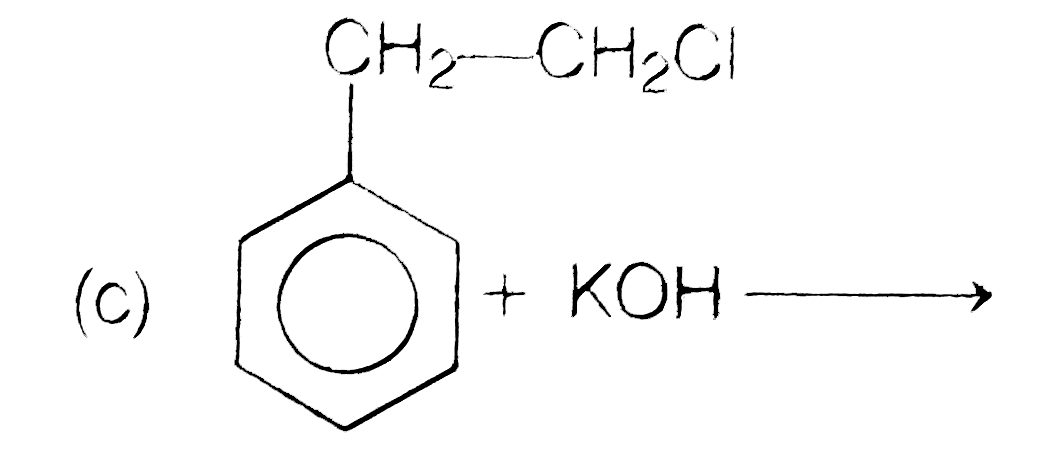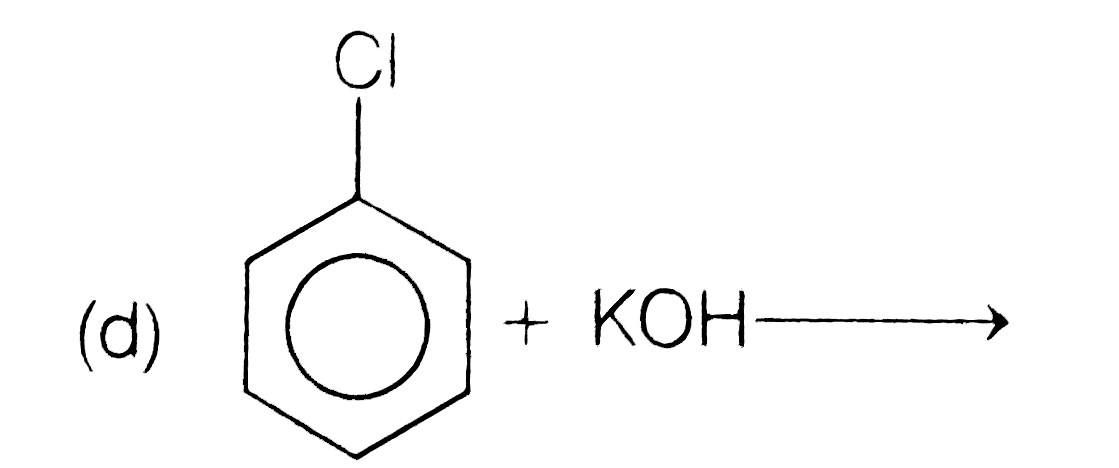SN1 reaction is favoured by _________.
non-polar solvents
bulky groups on the carbon atom attached to the halogen atom
small groups on the carbon atom attached to the halogen atom
strong nucleophile
The correct Answer is:B
Step by step video, text & image solution for S_(N)1 reaction is favoured by _________. by Chemistry experts to help you in doubts & scoring excellent marks in Class 12 exams.
Updated on:21/07/2023Topper's Solved these Questions
- HALOGEN DERIVATIVES OF ALKANES AND ARENESBOOK - TARGET PUBLICATIONCHAPTER - HALOGEN DERIVATIVES OF ALKANES AND ARENESEXERCISE - CRITICAL THINKING
76 Videos
- HALOGEN DERIVATIVES OF ALKANES AND ARENESBOOK - TARGET PUBLICATIONCHAPTER - HALOGEN DERIVATIVES OF ALKANES AND ARENESEXERCISE - COMPETITIVE THINKING
81 Videos
- GENERAL PRINCIPLES AND PROCESSES OF ISOLATION OF ELEMENTSBOOK - TARGET PUBLICATIONCHAPTER - GENERAL PRINCIPLES AND PROCESSES OF ISOLATION OF ELEMENTSEXERCISE - Evaluation Thinking
15 Videos
- MODEL QUESTION PAPERBOOK - TARGET PUBLICATIONCHAPTER - MODEL QUESTION PAPEREXERCISE - MODEL QUESTION PAPER-II
47 Videos
Similar Questions
Knowledge Check
SN1 reaction is faster in
ACH3CH2ClB CCH3−CH3∣C∣CH3−ClDCH3−CH∣∣CH2∣CH3−Cl
CCH3−CH3∣C∣CH3−ClDCH3−CH∣∣CH2∣CH3−ClSN1 reaction is feasible in
A B
B C
C D
D
SN2 reaction are
Astereoselective as well as atereopecificBstereoselective but not stereospecificCstereospecific but not stereoselectiveDNeither stereospecific nor stereoselective
The high reactivity of alkyl halides can be explained in terms of nature of C−X bond which is a highly polarised covalent bond. This polarity is responsible for the nucleophilic substitution reaction of alkyl halides which jmostly occur by SN1andSN2 mechanisms. SN1 reaction is a two step process and in the first step R−X ionises to give carbocation (slow process). IN the second step, the nucleophile attacks the carbocation from either side to form the product (fast process). IN SN1 reaction, there can be racemization and inversion. SN1 reaction is favoured by heavy (bulky) group on the carbon atom attached to halogens. IN SN2 reaction, the strong nucleophile OH− attacks fromt he opposite side
Of the halogen atom to give an intermediate (transition state), which breaks to yields to product (alcohol) and leaving group (X−). The alcohol has a configuratio opposite to that of the halide and is said to proceed with inversion of configuration. SN2 reaction is favoured by small groups on the carbon atom attached to halogen.
Q. Which among the following will not give SN1 reaction?
View SolutionThe high reactivity of alkyl halides can be explained in terms of nature of C−X bond which is a highly polarised covalent bond. This polarity is responsible for the nucleophilic substitution reaction of alkyl halides which jmostly occur by SN1andSN2 mechanisms. SN1 reaction is a two step process and in the first step R−X ionises to give carbocation (slow process). IN the second step, the nucleophile attacks the carbocation from either side to form the product (fast process). IN SN1 reaction, there can be racemization and inversion. SN1 reaction is favoured by heavy (bulky) group on the carbon atom attached to halogens. IN SN2 reaction, the strong nucleophile OH− attacks fromt he opposite side
Of the halogen atom to give an intermediate (transition state), which breaks to yields to product (alcohol) and leaving group (X−). The alcohol has a configuratio opposite to that of the halide and is said to proceed with inversion of configuration. SN2 reaction is favoured by small groups on the carbon atom attached to halogen.
Q. Which of the following is an example of SN2 reaction?
View SolutionThe high reactivity of alkyl halides can be explained in terms of nature of C−X bond which is a highly polarised covalent bond. This polarity is responsible for the nucleophilic substitution reaction of alkyl halides which jmostly occur by SN1andSN2 mechanisms. SN1 reaction is a two step process and in the first step R−X ionises to give carbocation (slow process). IN the second step, the nucleophile attacks the carbocation from either side to form the product (fast process). IN SN1 reaction, there can be racemization and inversion. SN1 reaction is favoured by heavy (bulky) group on the carbon atom attached to halogens. IN SN2 reaction, the strong nucleophile OH− attacks fromt he opposite side
Of the halogen atom to give an intermediate (transition state), which breaks to yields to product (alcohol) and leaving group (X−). The alcohol has a configuratio opposite to that of the halide and is said to proceed with inversion of configuration. SN2 reaction is favoured by small groups on the carbon atom attached to halogen.
Q. Which one of the following compounds is most readily hydrolysed by SN1 mechanism.?
View SolutionThe high reactivity of alkyl halides can be explained in tems of nature of C-X bond which is highly polarised covalent bond due to large difference in the electronegativities of carbon and halogen atom. This polarity is responsible for the nucleophilic substitution reaction of alkyl halides which mostly occur by SN1 and SN2 mechanisms. SN1 reaction is a two step process and in the first step R-X ionises to give carbocation (slow process). In the second step the nucleophilic attacks the carbocation from either side to form the prodcut (fast process) . In SN1 reaction there can be reacemization and inversion . SN1 reaction is favoured by heavy (bulky) groups on the carbon atom attached to halogens.
i.e., R3C−X>R2CH−X>RCH2X>CH3X. In SN2 reaction the strong nucleophilie OH− attacks from the opposite side of the chlorine atom to give an inyermediate (transition state).
which breaks to yield the product (alcohol) and leaving (X−) group. The alcohol has a configuration opposite to that of the bromide and is said to proceed with inversion of configuration. SN2 reaction is favoured by small groups on the carbon atom attached to halogen i.e., CH3−X>R−CH2X>R2CHX>R3C−X
SN1 reaction of optically active alkyl halide leads to :
View SolutionThe high reactivity of alkyl halides can be explained in tems of nature of C-X bond which is highly polarised covalent bond due to large difference in the electronegativities of carbon and halogen atom. This polarity is responsible for the nucleophilic substitution reaction of alkyl halides which mostly occur by SN1 and SN2 mechanisms. SN1 reaction is a two step process and in the first step R-X ionises to give carbocation (slow process). In the second step the nucleophilic attacks the carbocation from either side to form the prodcut (fast process) . In SN1 reaction there can be reacemization and inversion . SN1 reaction is favoured by heavy (bulky) groups on the carbon atom attached to halogens.
i.e., R3C−X>R2CH−X>RCH2X>CH3X. In SN2 reaction the strong nucleophilie OH− attacks from the opposite side of the chlorine atom to give an inyermediate (transition state).
which breaks to yield the product (alcohol) and leaving (X−) group. The alcohol has a configuration opposite to that of the bromide and is said to proceed with inversion of configuration. SN2 reaction is favoured by small groups on the carbon atom attached to halogen i.e., CH3−X>R−CH2X>R2CHX>R3C−X
An SN2 reaction at an asymmetric carbon of a compound always gives:
View Solution
